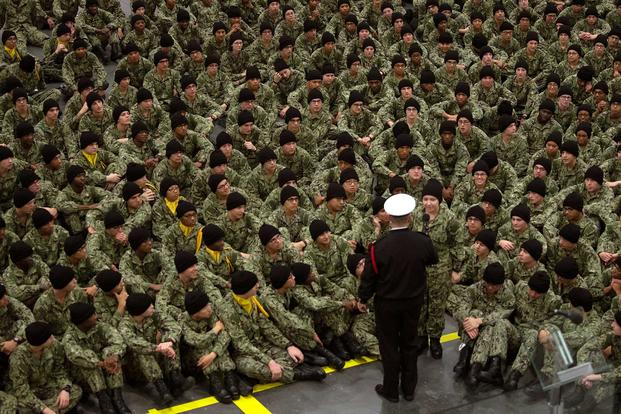New sailors are expected to retain a lot of information, from the Sailor's Creed to the complex Navy rank structure and a whole lot more. Fortunately for new recruits, this is exactly the sort of stuff you learn during your eight-week training aboard Naval Station Great Lakes.
Of course, there's a lot of other stuff recruits are expected to learn during their tenure at recruit training, so anything you can manage to absorb before your first day of boot camp will give you a significant leg up. With that concept in mind, here are a few things you could benefit from learning before arriving at recruit training to ensure you're set up for success.
Make sure to check out our other piece on preparing for Navy Recruit Training here.
Read next: History of U.S. Navy uniforms
The Sailor's Creed
The Navy's Sailor's Creed emphasizes the importance of self-respect, respect for others and the Navy's core values of honor, courage and commitment. As the Navy points out, the Sailor's Creed is a part of the Navy's very culture and often is recited similarly to students reciting the Pledge of Allegiance in school.
The creed itself was first adopted in 1993, but its roots in the Navy reach back much further than that. Here's the Navy's Sailor's Creed:
I am a United States Sailor.
I will support and defend the Constitution of the United States of America and I will obey the orders of those appointed over me.
I represent the fighting spirit of the Navy and those who have gone before me to defend freedom and democracy around the world.
I proudly serve my country's Navy combat team with Honor, Courage and Commitment.
I am committed to excellence and the fair treatment of all.
The 11 General Orders of a Sentry
You'll be required to know the 11 General Orders during your time at recruit training and regularly will be tasked with reciting them from memory. These orders will help you to understand your responsibilities on post, and it's generally recommended that you commit them to memory before leaving for boot camp.
1. To take charge of this post and all government property in view.
2. To walk my post in a military manner, keeping always on the alert and observing everything that takes place within sight or hearing.
3. To report all violations of orders I am instructed to enforce.
4. To repeat all calls from posts more distant from the Guardhouse than my own.
5. To quit my post only when properly relieved.
6. To receive, obey and pass on to the sentry who relieves me all orders from the Commanding Officer, Command Duty Officer, Officer of the Deck, and Officers and Petty Officer of the Watch only.
7. To talk to no one except in the line of duty.
8. To give the alarm in case of fire or disorder.
9. To call the Officer of the Deck in any case not covered by instructions.
10. To salute all officers and all colors and standards not cased.
11. To be especially watchful at night, and during the time for challenging, to challenge all persons on or near my post, and to allow no one to pass without proper authority.

Navy Tattoo Policy
The Navy utilizes four pieces of criteria when assessing whether or not your tattoos are permitted: content, location, size and cosmetic. You'll have to go over these with your recruiter before shipping to recruit training if you're concerned about any of your tattoos.
Content: Put simply, the Navy does no permit tattoos that could be seen as obscene, sexually explicit or in any way discriminatory. Likewise, you can't have any tattoos or brands that indicate membership in a gang or extremist groups, or that encourages the use of drugs.
Location: Tattoos are not permitted on the head, face, ears or scalp, though one small tattoo (not to exceed one inch) is permitted on the neck or behind the ear. Tattoos on the torso of the body should not be visible in uniform.
Size: Size restrictions are only in place on tattoos placed on the neck or behind the ear, which are not to exceed one inch in any direction. There is no limit to the size of tattoos on limbs or your torso.
Cosmetic: Cosmetic tattoos meant to correct medical conditions are subject to different rules, as dictated by the medical staff.
Your Chain of Command at Recruit Training
As a recruit training to serve in the Navy, you may be required to know a number of levels of your chain of command. This information is not only essential for good military order, it's also a crash course in the framework of the Navy's command infrastructure.
As a recruit, this is what your chain of command looks like, from the top down:
- President of the United States
- Secretary of Defense (SECDEF)
- Secretary of Navy (SECNAV)
- Chief of naval operations (CNO)
- Master chief petty officer of the Navy (MCPON)
- Chief of naval personnel (CNP)
- CNP fleet master chief petty officer
- Commander, Naval Education and Training Command (CNETC)
- NETC force master chief petty officer
- Commander, Naval Service Training Command (CNSTC)
- NSTC command master chief petty officer
- Commanding officer, Recruit Training Command (RTC)
- Executive officer, Recruit Training Command
- Military training director (MTD)
- MTD leading chief petty officer
- Fleet commander
- Fleet leading chief petty officer
- Ship's officer
- Ship's leading chief petty officer
- Recruit division commander (three per division)
Beginner Drill Etiquette
While a good portion of your time at Great Lakes will revolve around practicing drill, you'll be a step ahead of your peers if you arrive with a basic understanding of a few fundamental commands and positions.
Attention
The position of attention may be the most important one to get right before you arrive for recruit training, and is the most basic of all military positions. Upon receiving the command of "attention," bring the heel of your left foot to the heel of your right and stand straight up. Your feet should remain at a 45-degree angle, chest out, with your thumbs resting on the seams of your trousers.
The part new recruits tend to get wrong most often is hand placement. Make sure your thumbs are touching your trouser seems and you're good to go, even if it feels more natural to let your hands sit further forward.
Parade Rest
When given the command, "parade rest," pick up your left foot and bring it to approximately shoulder width apart from your right and join your hands behind you (right over left). Your palms should be facing away from your body.
At Ease
When given the command, "at ease," your right foot must remain in place, but you otherwise can relax and move as you wish.
Fall In and Fall Out
When given the command to fall in, head to your designated place in the formation and stand at attention. When given the command to "fall out," you may break ranks and go about your day.
Navy Policy on Earrings and Rings
Rings are generally acceptable for both male and female sailors, provided you wear only one per hand (with the exception of a wedding band/engagement ring combination). You can't "double stack" rings or wear large or bright colored rings in uniform.
Men are not authorized to wear earrings while in uniform, nor are they permitting in civilian attire any time you're in a duty status or are serving aboard a ship. Basically, you can wear earrings inside your house, but better not any time you're on base or ship.
Women are authorized one earring per ear, and when in uniform, the color is dictated by your rank. Officers and CPOs wear gold, while E6s and below should wear silver.
Body piercings are not permitted.
This information has been updated. Read the original article on Sandboxx.
Want to Know More About the Navy?
Be sure to get the latest news about the Navy, as well as critical info about how to join and all the benefits of service. Subscribe to Military.com and receive customized updates delivered straight to your inbox.














